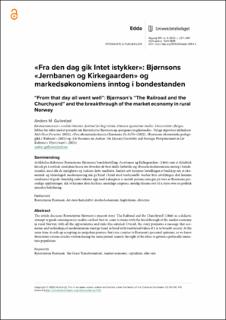| dc.contributor.author | Gullestad, Anders M | |
| dc.date.accessioned | 2023-01-17T13:00:48Z | |
| dc.date.available | 2023-01-17T13:00:48Z | |
| dc.date.created | 2023-01-05T14:25:17Z | |
| dc.date.issued | 2022 | |
| dc.identifier.issn | 0013-0818 | |
| dc.identifier.uri | https://hdl.handle.net/11250/3044043 | |
| dc.description.abstract | Artikkelen diskuterer Bjørnstjerne Bjørnsons bondefortelling «Jernbanen og Kirkegaarden» (1866) som et didaktisk forsøk på å rettlede samtidens lesere om hvordan de best skulle forholde seg til markedsøkonomiens inntog i bondestanden, med alle de muligheter og risikoer dette medførte. Samlet sett fremmer fortellingen et budskap om at økonomisk og teknologisk modernisering må gå hånd i hånd med tradisjonelle verdier hvis utviklingen skal komme samfunnet til gode. Samtidig ender teksten opp med å akseptere et uuttalt premiss som går på tvers av Bjørnsons personlige oppfatninger, slik vi kjenner dem fra hans samtidige sakprosa, nemlig elitenes rett til å styre over en politisk umoden befolkning. | en_US |
| dc.description.abstract | The article discusses Bjørnstjerne Bjørnson’s peasant story ‘The Railroad and the Churchyard’ (1866) as a didactic attempt to guide contemporary readers on how best to come to terms with the breakthrough of the market economy in rural Norway, with all the opportunities and risks this entailed. Overall, the story promotes a message that economic and technological modernization must go hand in hand with traditional values if it is to benefit society. At the same time, it ends up accepting an unspoken premise that runs counter to Bjørnson’s personal opinions, as we know them from various articles written during the same period: namely the right of the elites to govern a politically immature population. | en_US |
| dc.language.iso | nob | en_US |
| dc.publisher | Universitetsforlaget | en_US |
| dc.rights | Navngivelse-Ikkekommersiell 4.0 Internasjonal | * |
| dc.rights.uri | http://creativecommons.org/licenses/by-nc/4.0/deed.no | * |
| dc.title | «Fra den dag gik Intet istykker»: Bjørnsons «Jernbanen og Kirkegaarden» og markedsøkonomiens inntog i bondestanden | en_US |
| dc.type | Journal article | en_US |
| dc.type | Peer reviewed | en_US |
| dc.description.version | publishedVersion | en_US |
| dc.rights.holder | Copyright 2022 The Author(s) | en_US |
| cristin.ispublished | true | |
| cristin.fulltext | original | |
| cristin.qualitycode | 2 | |
| dc.identifier.doi | https://doi.org/10.18261/edda.109.4.2 | |
| dc.identifier.cristin | 2101405 | |
| dc.source.journal | Edda. Nordisk tidsskrift for litteraturforskning | en_US |
| dc.source.pagenumber | 227-240 | en_US |
| dc.identifier.citation | Edda. Nordisk tidsskrift for litteraturforskning. 2022, 109 (4), 227-240. | en_US |
| dc.source.volume | 109 | en_US |
| dc.source.issue | 4 | en_US |

